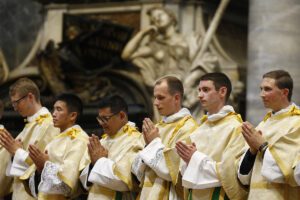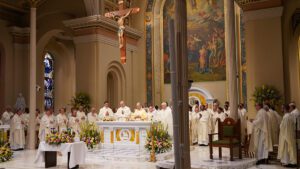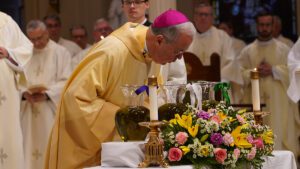(OSV News) – Ahead of an annual day of prayer for vocations, a newly released report shows what one researcher called greater “consistency of age,” more diverse educational backgrounds and a commitment to Eucharistic adoration among men preparing for priestly ordination.
On April 25, the Center for Applied Research in the Apostolate (CARA) at Georgetown University released the 2023 “Survey of Ordinands to the Priesthood,” a report made directly to the Secretariat of Clergy, Consecrated Life and Vocations of the U.S. Conference of Catholic Bishops.

The report coincides with the 60th annual World Day of Prayer for Vocations, celebrated April 30, the Fourth Sunday of Easter, which is also known as Good Shepherd Sunday in the Latin Church. The Gospel passage (Jn 10:1-10) for the Mass highlights Jesus’ role as the Good Shepherd.
The online survey, which CARA has overseen since 2006, was completed by 334 of the 458 total ordinands from both diocesan and religious order seminaries who were invited to participate. The ordinands represented 116 U.S. dioceses and 24 religious institutes.
CARA’s executive director, Jesuit Father Thomas Gaunt, told OSV News the age of men set to be ordained this year has “started to level out,” with “more consistently younger men entering seminary and beginning their theological studies in their early 20s — basically after having finished college — and then being ordained four to five years or so later.”
Overall, this year’s ordinands are on average 33 years old, with ordinands from religious institutes generally four years older than their diocesan counterparts.
That trend contrasts with “a notable number of older vocations” seen some “20 to 30 years ago,” said Father Gaunt. “Now, it’s a little more unusual to see a seminarian or someone entering the novitiate for a religious community entering at age 40 or 45.”
Among 2023’s ordinands, the elementary school (32%) and high school (26%) years were the peak periods for them in first considering a vocation, followed by the college years (19%).
The data also showed what Father Gaunt called a “steady increase in Hispanic ordinands year over year,” with 16% of the 2023 class identifying as Hispanic/Latino — a trendline set to rise to about 20% by 2028.
White ordinands accounted for 64% of the 2023 class, with 10% Asian and Pacific Islander, 6% Black or African, and 3% representing other ethnic backgrounds.
A significant number of the 2023 ordinands (25%) were born abroad. After the U.S., the most common countries of birth were Mexico (5%), Vietnam (3%), Nigeria (3%) and Colombia (2%).
That statistic is “basically on par” with one showing that “fully one quarter of all Catholics in this country are foreign born,” explained Father Gaunt.
While the majority (89%) of ordinands were not homeschooled, the data indicated the 11% who were educated at home (for an average of 8 years, among the 2023 class) could rise to an estimated 13% by 2028.
Ordinands who attended Catholic elementary school represented 43% of this year’s class; 34% of the 2023 ordinands attended Catholic high schools, and 35% attended Catholic colleges. Two thirds of the class (66%) had attended parish religious education programs.
The majority of 2023 ordinands had obtained a college (42%) or graduate (16%) degree prior to entering the seminary, with 18% having had some college or trade school study.
An array of pre-seminary areas of study among the ordinands have “added a whole richness to the priesthood,” said Father Gaunt.
“They begin this study with college degrees in their fields of interest or specialty, so you have a number of men coming in with bachelor’s degrees in business, finance, chemical engineering, English, education, history,” he said.
Such diversity also was reflected in the full-time work experience of ordinands prior to entering the seminary, with 21% employed in business, 18% in education, 14% in sales or customer service, and 13% in restaurant or food services.
Most of the 2023 ordinands (74%) had no educational debt upon entering the seminary. The remaining 26% averaged just over $29,500 of debt, with the lowest amount reported at $1,500 and the highest at $126,000.
Diocesan ordinands (averaging $26,579) tended to have more than double the educational debt of their religious order counterparts (averaging $11,887). Family members (44%) provided the greatest amount of assistance in paying down ordinands’ debt, followed by the Knights of Columbus Fund for Vocations (24%) and parishes (10%).
Regular Eucharistic adoration figured heavily in the pre-seminary prayer practices of the class of 2023, cited by 73% of the survey participants. Following adoration was the rosary (66%), prayer group or Bible study (45%), high school retreats (37%) and “lectio divina” (35%).
Survey respondents listed among their pre-seminary activities parish youth groups (52%), Catholic campus ministry (27%), Boy Scouts (25%), parish young adult groups (23%) and the Knights of Columbus (23%).
A majority of the 2023 ordinands, 72%, had been altar servers; 51% had been lectors, 40% extraordinary ministers of holy Communion and 33% catechists.
Most cited parish priests (63%) as those who most encouraged their vocation, followed by parishioners (44%), friends (40%), mothers (37%) and fathers (29%).
Just under half of the ordinands (48%) reported being discouraged from pursuing their vocations, with another family member (21%) or friend (21%) usually cited.
Seminary “come and see” weekends were attended by 49% of the ordinands, particularly among those entering religious orders (75%).
Overall, the report offers “hope” regarding priestly vocations, said Father Gaunt, especially as demographers continue to assess the impact of the COVID-19 pandemic on religious practices.
“We want to get a couple of more years out from the pandemic,” he said. “We’re still not sure what’s an ordinary response, and what is more pandemic-related. … We’ll tell you in five years.”


